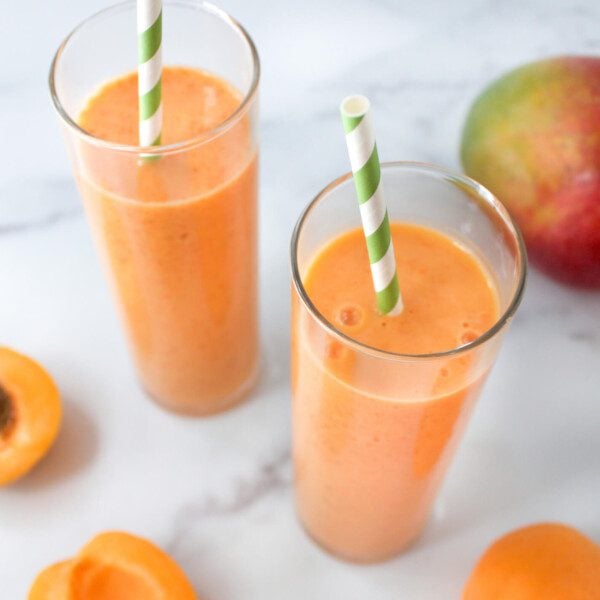How to Select Apricots
- Select apricots that are plump, firm, and have a deep orangish-gold color.
- Unripe apricots will be hard. Overripe apricots will be squishy. Ripe apricots will have a floral aroma.
- Avoid apricots that are squishy, pale yellow or green, or that have large blemishes.
https://www.theproducemoms.com/produce/apricots/
When are Apricots in Season?
Fresh apricots are in season from late spring to early summer, typically May through July in the US. Dried apricots can be found year-round. If you’re looking for the best apricots for eating, the ones harvested closest to their peak ripeness period are the most flavorful.
Varieties of Apricots
Apricots are an incredibly nutritious and delicious stone fruit that has been enjoyed for centuries. There are a wide variety of apricots, each with its own distinct color and flavor profile.
The common apricot is the most widely consumed apricot variety in the world. It has bright orange-red skin with yellowish-white or light orange flesh that’s soft and juicy when ripe. The common apricot has a sweet taste, often with hints of tartness or bitter almond flavor.
Harglow apricots are another popular apricot variety. Characterized by its very large size and deep golden color, Harglow apricot flesh is firm and extremely sweet with a hint of tartness.
The Moorpark apricot is best known for its bright orange color and deep red-hued flesh. It has a sweet, almost honey-like flavor that many apricot fans love.
Blenheim apricots are often referred to as the “queen” of apricots. This is due to their flavor being described as “unbelievably fragrant” and having a special sweetness. Its yellowish-orange skin often has rosy blushes, while its flesh is soft and juicy when ripe.
Apricot Nutrition Facts & Benefits
1 cup of apricots provides,
- approx 74 calories
- 1 gram of fat
- 2 grams of protein
- 17 grams of carbohydrates
- 14 grams of natural sugar
- 3 grams of fiber
Here are just a few of the many ways that apricots can benefit your health:
1) Apricots contain vitamin C, dietary fiber, and potassium, all of which may help maintain healthy blood pressure levels and reduce the risk of heart disease. They also have antioxidant compounds that protect against oxidative damage in the heart and other organs.
2) The fiber found in apricots helps to keep digestion regular and aids in the removal of toxins from the body. This is important for maintaining digestive balance and promoting overall gut health.
3) Apricots are rich in carotenoids like lutein and zeaxanthin, which are great for eye health. These compounds help protect against age-related macular degeneration, cataracts, and other conditions that can lead to vision loss.
4) Apricots provide vitamin K, which helps support bone health by increasing calcium absorption in the body. They also contain boron, a mineral important for healthy bones and joints.
In addition to these benefits, apricots are an excellent source of energy-boosting carbohydrates so you have the fuel you need to get through your day!
How to Store Apricots
How To Store Apricots: Store apricots at room temperature and away from direct sunlight until they are ripe. Once they are ripe, if you’re not ready to eat them, place them in the refrigerator to halt the ripening process.
How To Freeze Apricots: Begin by washing and drying the apricots. Cut in half and remove the pits. Either leave them as halves or cut them into chunks. Place the apricot pieces on a baking sheet and flash freeze. Once the pieces are frozen through, transfer them to a freezer bag or airtight container. Freeze for up to a year.
How to Prepare Apricots
Here’s how to prepare apricots for the best taste depending on the dish,
- Rinse apricots in cold water to remove any dirt or debris before eating them fresh.
- To peel apricots, make a small slit in the skin with a paring knife and gently pull it away from the flesh with your fingers.
- Slice apricots into wedges for salads or desserts like apricot crumble or tart.
- Halve apricots for recipes such as apricot chicken or apricot sauce.
- To dry apricots, cut them in half, remove the pits and spread the halves onto a baking sheet lined with parchment paper. Bake at a low temperature (150-200 F) until they are dried but still pliable to the touch.
- For apricot jam or preserves, cook halved apricots in sugar syrup until soft and then mash them before adding pectin and other ingredients to make the jam.
- Cook apricots with honey and cinnamon for a delicious compote that can be served over ice cream or yogurt, or use apricots in baked goods like turnovers, pies, cakes, and tarts.
No matter how you decide to prepare apricots, there’s no doubt that apricots make for a delicious and nutritious snack or addition to any meal! Enjoy!



